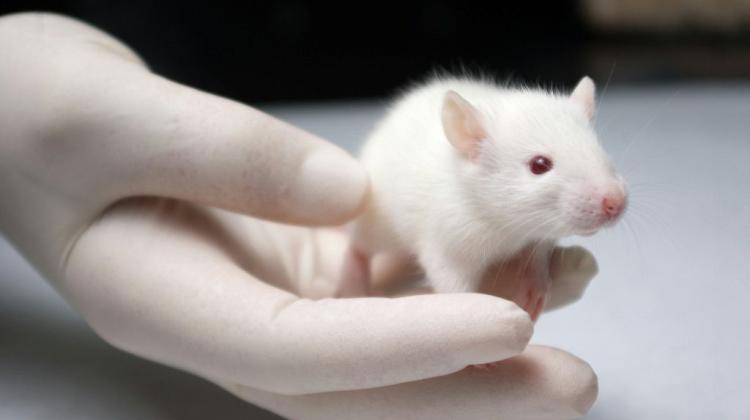Rat pessimists will help to understand depression

Are pessimists more prone to depression among people? It is very difficult to check. The answer, however, could be provided by studies on rats. It turns out that also among them there are optimists and pessimists. In addition symptoms that resemble depression can be induced in rats.
"We are engaged in experimental psychology. In my research I try to model on animals the cognitive processes associated with mental illness, including depression" - said in an interview with PAP Dr. Rafal Ryguła from the Institute of Pharmacology PAS in Kraków. For his postdoctoral work on the subject the researcher received one of the prizes of the President of the Council of Ministers.
In his research the scientist focused on the relationship between cognitive bias, manifested as optimism or pessimism, and mental illness. "We want to find out, for example, whether the pessimistic animals are more susceptible to stress-induced depression symptoms than the optimists - and whether optimistic and pessimistic animals react differently to treatment with antidepressants" - concluded Dr. Ryguła.
RAT OPTIMISTS AND PESSIMISTS
According to Dr. Ryguła, only recently (2004) scientists learned how to study optimism and pessimism in rats. Rodents are taught to respond to sounds: high and low tones. When there is a high tone, the animal must press the lever on the left to get the reward. If the rat hears a low tone, it must press the right lever to avoid punishment. "When rodents learn that, we play a midrange tone - between high and low. Optimism can be measured by observing how rats evaluate the ambiguous signal. Optimistic rat reacts as if were to get a reward. A pessimistic one - as if it were to receiver punishment" - the researcher explained.
Optimism and pessimism in rats, as in humans, can be a transitory state or a permanent trait of an individual. The fact that pessimism and optimism in rats may be their permanent feature, has been described by researchers from the Institute of Pharmacology PAS.
The researchers also checked whether cognitive bias in rats can be manipulated - for example, whether optimism or pessimism can be induced pharmacologically. "We also investigated whether optimism can be induced by emotion ... And so, for example, we tickled rats to see whether happy animals would be more optimistic in their decisions. They were" - revealed the researcher.
Dr. Ryguła and his team also decided to check whether the pessimistic rats would be more susceptible to stress and depression. It was a correct hypothesis. "We have shown that pessimism as a feature may determine animal\'s sensitivity to stress-induced anhedonia, which is one of the main symptoms of depression" - said the scientist.
DEPRESSION IN RAT? IT\'S A FACT!
There is a problem with studying of depression in a rat model. "Researchers do not agree. Some believe that rats may suffer from depression - others, that it is nonsense. But we have models that significantly resemble what characterizes depression in humans. So we can use rats to model psychological aspects that occur in sick people" - said the researcher.
"One of the main symptoms of depression is pathological inability to experience pleasure. Patients with depression cease to want to have fun, meet with friends, have good food and sex. Researchers from the Institute of Pharmacology PAS specialize in modelling similar anhedonia in animals. They can induce a state in which the animal no longer feels pleasure"- said the scientist. He explained that in animals a symptom of this state is that the rodent does not prefer a delicacy - sugar water - over the usual water with no sugar.
The scientist explains that the study of induction of anhedonia in rats have evolved. "The first models from the 1960s consisted in physically stressing the rodents. In time, animals started to show helplessness and anhedonia. However, while the symptoms resemble depression, their source was not similar to depression - depression in humans is not a result of physical stress. Experiments were not sufficiently reliable. In more recent experiments on rats, scientists simulate >>inconveniences of everyday life<< - for example skew the cage or soak their bedding" - said the researcher. He explained that if such impediments persist, rats show signs of depression.
"In humans, depression often results from psychosocial stress, so in rats these conditions are simulated, for example, by isolating them or placing them in a cage with an unknown individual. It is a kind of social stress, so the reliability of the study is higher" - explained the researcher.
"Our research shows that, firstly, the pessimistic cognitive bias may be a marker of depressive diseases. Secondly, it seems that optimism and pessimism can be induced by pharmacologically stimulating the neurotransmitters that are involved in depression. Therefore, there is a common part between pessimism and depression. And thirdly drugs that modulate optimism in animals can be used in humans for the treatment of depression" - concluded the scientist from the Institute of Pharmacology PAS.
He admitted that demonstrating the relationship between pessimism and depression in humans would be extremely difficult. "To link a feature of pessimism to subsequent probability of depression, you would have to study the entire population. We do not have access to such studies, hence the need to conduct experiments on animals. Perhaps one day, if it is confirmed that pessimism can be a predictor of depression in people, studies of pessimism and optimism in humans will become commonplace" - he added.
PAP - Science and Scholarship in Poland, Ludwika Tomala
lt/ agt/ zan/
tr. RL
Przed dodaniem komentarza prosimy o zapoznanie z Regulaminem forum serwisu Nauka w Polsce.


















